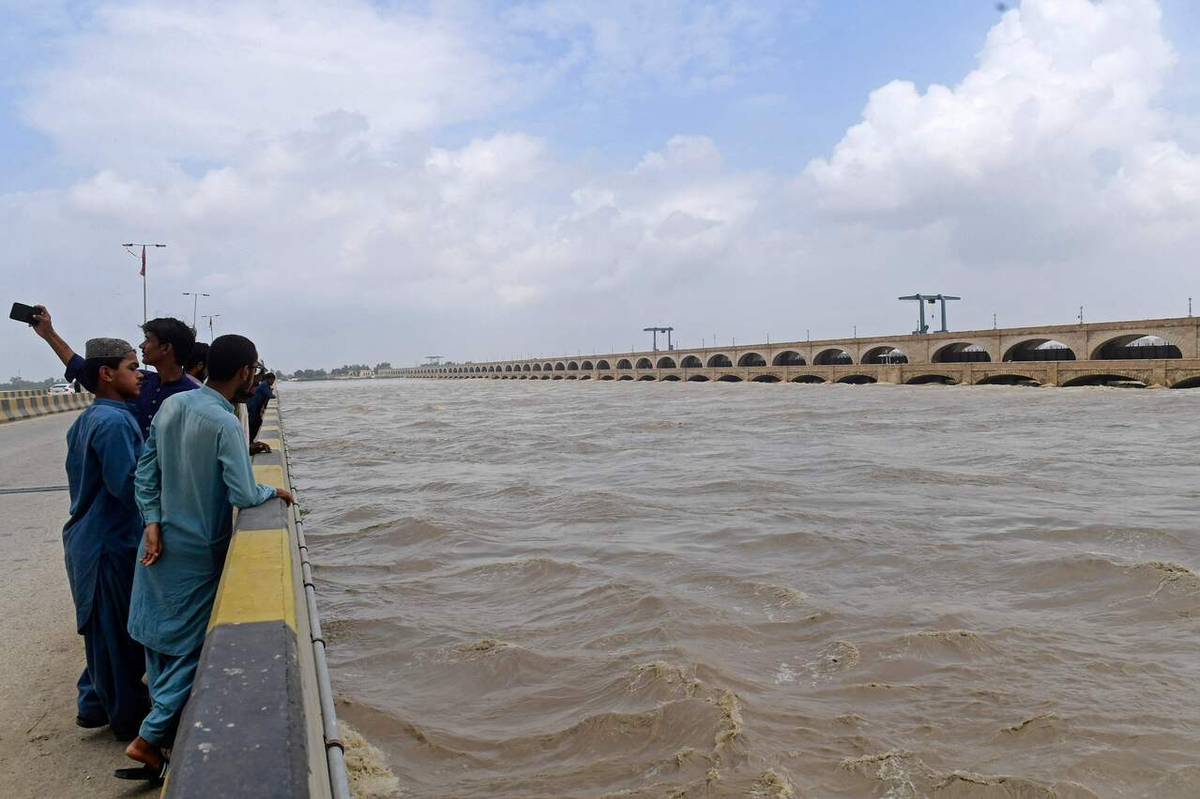Record river surges in Punjab put southern Pakistan at risk of flooding
PDMA warns of 700,000-800,000 cusecs at Guddu Barrage; Punjab floods kill 20 as Ravi, Chenab swell
News Desk
The News Desk provides timely and factual coverage of national and international events, with an emphasis on accuracy and clarity.

Haider Amin
Correspondent, Nukta
Haider Amin is a multimedia broadcast journalist with an experience of almost 18 years. Served media industry as reporter, associate executive producer and head of packaging department.

File photo showing people capturing selfies at Sukkur Barrage.
AFP/File
Pakistan is bracing for a major flood threat as record-high water flows are expected to hit the Guddu Barrage in Sindh province next week.
Rising river levels in upstream areas of Punjab and northern Pakistan are raising concerns, prompting authorities to mobilize large-scale rescue and relief operations to protect tens of thousands of vulnerable families.
Pakistan’s Sindh province is preparing for potentially strong floods as inflows at the Guddu Barrage on the Indus River near Kashmore in northern Sindh are projected to reach record levels. The barrage, a key irrigation and flood-control structure, regulates river flow and diverts water to canals supporting millions of acres of farmland. When inflows surge, downstream communities face heightened risk, making timely preparedness crucial.
Sindh Chief Minister Syed Murad Ali Shah called a high-level emergency meeting to review flood readiness ahead of the anticipated peak flows entering the province via Guddu Barrage on September 3-4.
The urgency comes as heavy rainfall and glacial melt in northern Pakistan and parts of Punjab continue to swell the Indus River.
According to the Provincial Disaster Management Authority (PDMA), inflows of 700,000 to 800,000 cusecs are expected at Guddu Barrage between Wednesday and Thursday night. Such a surge could overwhelm embankments and inundate low-lying settlements, prompting authorities to mobilize comprehensive rescue and relief measures.
During the meeting, CM Shah directed all relevant departments to remain on high alert and assigned ministers and officials to supervise flood management along both the right and left banks of the river. “Our priority is to ensure that not a single human or animal life is lost,” he emphasized.
Currently, 72 rescue boats have been deployed in northern districts and 106 in southern districts, supported by over 30,000 Rescue 1122 personnel. Specific allocations include six boats at Sukkur, four each at Ghotki, Khairpur, Shikarpur, Naushahro Feroze, and Dadu, and three at Shaheed Benazirabad. The Pakistan Navy has also placed 26 boats on standby for relief operations.
The PDMA confirmed that sufficient relief supplies, including tents, blankets, kitchen sets, mattresses, portable toilets, mosquito nets, first-aid kits, de-watering pumps, and generators, are ready for immediate deployment. More than 500 emergency camps are planned along river embankments to shelter affected communities and safeguard livestock. Authorities warn that in the event of very high floods, over 50,000 families could be displaced, necessitating a rapid response and possibly additional heavy machinery sourced from the private sector.
Punjab flood situation
The flood threat is also intensifying in Punjab, where rising water levels in the Ravi and Chenab rivers are endangering major population centers. Director-General PDMA Punjab, Irfan Ali Kathia, has held multiple press conferences over the past 48 hours, issuing urgent warnings and providing updates on the evolving crisis.
He reported that isolated areas have already experienced light to heavy rainfall, and the provincial capital is now at risk.
Water levels have surged above 100,000 cusecs at Balloki, prompting concerns over urban flooding in Sheikhupura, Nankana, and surrounding areas.
More than 20 people have died due to floods in Punjab, and the provincial government has evacuated over one million residents, establishing 1,372 relief camps to accommodate displaced families.
Emergency teams remain on high alert as inflows continue to rise, and authorities are urging citizens in low-lying areas to move to safer ground and cooperate with evacuation efforts. The flood is expected to reach Khanewal within the next 24 hours.










Comments
See what people are discussing